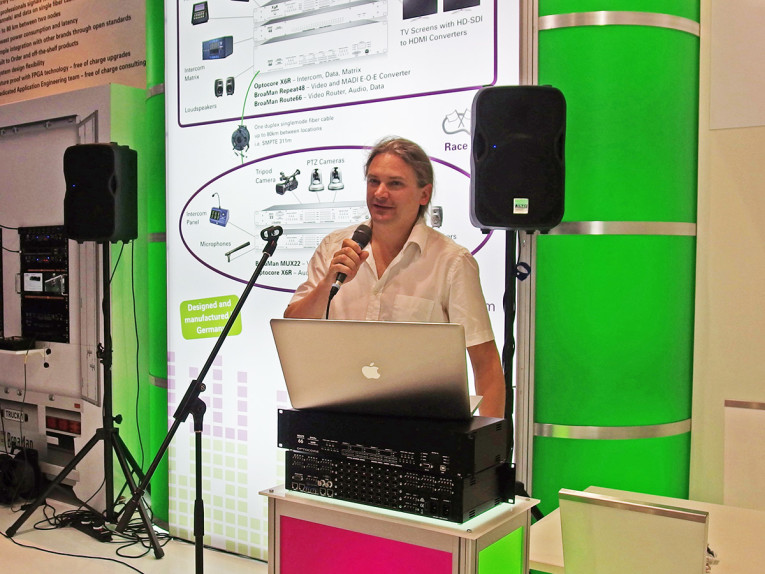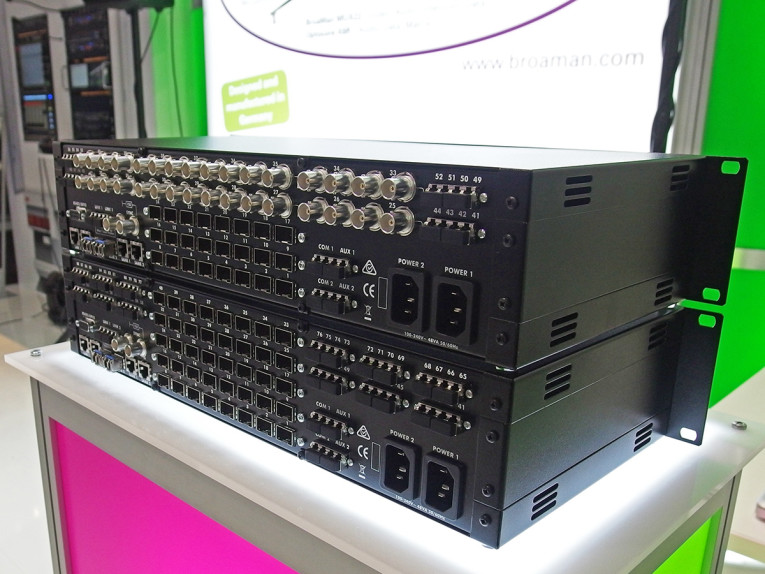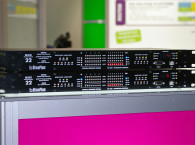
Since digital signals became the norm in the broadcast and professional AV production industry, some companies identified the need to create flexible and reliable signal distribution and routing solutions, for time critical applications. Systems able to deal simultaneously with multiple uncompressed audio and video signals, together with timecode, intercom, control and a reliable sync infrastructure. Two decades ago, an early pioneer on those compact digital signal distribution solutions was German company Optocore, which managed to established its optical fibre products long before any other standard IT network approach.
Optocore became a reference for reliable and high-quality audio signal distribution, based on the open AES3 and AES10 (MADI) standards and gradually evolved to carrying also video signals using the same modular optical fibre ring concept for higher bandwidth infrastructures. This led to the creation of the separate company, BroaMan (Broadcast Manufactur GmbH) which provides a complete range of interfaces for every application that requires SD/HD/3G video transport or routing – from broadcast studios or OB Vans, to simple point to point for a conference hall. Currently the two brands intertwine in the Route66 routing concept, providing transport, routing, format conversion as well as distribution of audio, video and control data with full management and diagnostic capabilities.
As the founder and technical director of BroaMan/Optocore, Marc Brunke, explained at IBC 2016, the evolution of the Route66 platform was the gradual result of the company response to actual installations since it was invented as a custom solution for SVT, the Swedish National broadcaster, five years ago. Now, the company decided to expand the range in order to be able to offer standard units from which to configure virtually any routing system.
Available in three versions, the latest Route66 series will provide single channel, non-blocking 40 x 40 router ports in three versions — all with directly accessible fibre SFP (Small Form Factor Pluggable) or SDI. Additionally each new Route66 features fibre ports which can be used to access built-in CWDM or DWDM multiplexers. The expansion introduces a new 2RU design as a direct result of customer feedback and the multiple projects already delivered.

The first version of Route66 will offer fibre only, with 40 hot-swappable bi-directional SFPs; Version 2 will have 32 SFPs and 16 x SDI (8-In and 8-Out); Version 3 will have 24 SFPs and 32 SDI (16-In and 16-Out). All the new Route66 devices also contain an advanced Optocore network for audio and intercom - with support for ClearCom, RTS, Riedel and others - IP monitoring and control, routing and transport, as well as providing additional transport of GPIO, RS485 and LAN.
The new Route66 provides protocol-independent routing and transport, supporting all professional standards such as 3G, SDI, HD, 3G-SDI, ASI and MADI. The built-in redundant power supplies offer extremely low power consumption of 10-40W making the system significantly more cost efficient than competitive models which depend on external 120W PSU’s. The new models are designed with a very efficient passive cooling system, which replaces noisy fans; therefore the device fulfills all noise criteria.

Route66 devices are populated with router channels, I/O and multiplexers at the time of manufacturing, according to customer’s specifications. All connections are to the rear, making Route66 installation friendly. The front panel provides status information only, with no cabling or service buttons. The series can be controlled by Optocore Control software, external hardware or software control platform or by using automated routing, according to specifications. A full offline software is available for pre-configuration.
Route66 series is perfect for a customized studio infrastructure, acting as a centralized video, audio, data router with the company’s Mux22 or Repeat48 units connected as floor boxes providing the required I/O to the remote locations. Route 66 devices may as well be configured as switched or automatic Optocore routers, providing the capability to build Optocore networks in a star topology or as a mixture of ring- and star topology.
Finally, Route66 can become a part of a Video AutoRouting System array (as deployed at broadcasters, SVT in Sweden and the new ITV Coronation Street set at MediaCityUK in Manchester). Other valuable features include Video Sync transport with sync signals converter for the most commonly used signals: WC, BB, TriLevel; Camera CCU (without power) transport and routing up to 4G.
Currently, Optocore/BroaMan networks are used in a wide variety of environments, including opening and closing ceremonies of the world‘s most prominent events, as well as an alternative to copper infrastructures in OB vans, stadiums, studios and theaters. Systems scale down to point to point portable stageboxes with mixing console integration. All technologies and products are developed, manufactured and maintained by an in-house team, based in Munich, Germany.
www.broaman.com | www.optocore.com






